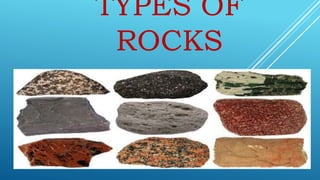
Types of rocks.pptx
- 2. 1. IGNEOUS ROCKS - are rocks formed by solidification or cooling of magma or lava
- 3. TWO TYPES OF IGNEOUS ROCKS 1. INTRUSIVE ROCKS – rocks formed underneath the earth. - they are coarse-grained due to the slow cooling of magma allowing crystal growth.
- 4. 2. EXTRUSIVE ROCKS – rocks formed on the surface of the earth. - they are fine-grained due to abrupt cooling on the surface. - they are cooled lava
- 6. ANDESITE
- 9. 2. SEDIMENTARY ROCKS are formed by the compaction and cementation of sediments, a process called lithification.
- 11. BRECIA CHALK
- 12. COAL DOLOMITE
- 13. SHALE
- 14. 3. METAMORPHIC ROCKS - These rocks can come from igneous rocks, sedimentary rocks or even from other metamorphic rocks. - are formed by preexisting rocks that are exposed to extreme heat and pressure in the Earth’s interior, a process called metamorphism.
- 17. MARBLE GNEISS
- 18. Key Characteristics of rocks 1.Crystals Small, flat surfaces that are shiny or sparkly, like tiny mirrors 2. Fossils Imprints of leaves, shells, insects, or other items in the rock. 3. Gas bubbles "Holes," like Swiss cheese, in the rock. 4. Glassy surface A shiny and smooth surface, like colored glass. 5. Ribbonlike layers Straight or wavy stripes of different colors in the rock. 6. Sand or pebbles Individual stones, pebbles, or sand grains visible in the rock.
- 19. How rocks change: The Rock Cycle The Rock Cycle - is a group of changes that occurs in rocks. - Igneous rock can change into sedimentary rock or into metamorphic rock. -Sedimentary rock can change into metamorphic rock or into igneous rock. - Metamorphic rock can change into igneous or sedimentary rock.
- 21. Processes in the Rock Cycle 1.Weathering & Erosion - These processes of breakdown and transport due to exposure to the environment are called weathering and erosion. - Weathering and erosion affect all rocks on the earth's surface.
- 22. 2. Compacting & Cementing - Over time, sediment accumulates in oceans, lakes, and valleys, eventually building up in layers and weighing down the material underneath. This weight presses the sediment particles together, compacting them. - The concept of the rock cycle is attributed to James Hutton (1726–1797), the 18thcentury founder of modern geology. - The main idea is that rocks are continually changing from one type to another and back again, as forces inside the earth bring them closer to the surface (where they are weathered, eroded, and compacted) and forces on the earth sink them back down (where they are heated, pressed, and melted). - So the elements that make up rocks are never created or destroyed — instead, they are constantly being recycled. The rock cycle helps us to see that the earth is like a giant rock recycling machine.
- 23. 3.Heat & Pressure - Due to movements in the crust, rocks are frequently pulled under the surface of the earth, where temperatures increase dramatically the farther they descend. - Between 100 and 200 kilometers (62 and 124 miles) below the earth's surface, temperatures are hot enough to melt most rocks. - An additional factor that can transform rocks is the pressure caused by tons of other rocks pressing down on it from above; heat and pressure usually work together to alter the rocks under the earth's surface. - This kind of change, which results from both rising temperature and pressure, is called metamorphism, and the resulting rock is a metamorphic rock.
- 24. 3. Melting - It takes a lot of heat to melt a rock. - The high temperatures required are generally found only within the earth. - The rock is pulled down by movements in the earth's crust gets hotter and hotter as it goes deeper. - It takes temperatures between 600 and 1,300 degrees Celsius (1,100 and 2,400 degrees Fahrenheit) to melt a rock, turning it into a substance called magma (molten rock).
- 25. 4. Cooling - Liquid magma also turns into a solid — a rock — when it is cooled. Any rock that forms from the cooling of magma is an igneous rock. - Magma that cools quickly forms one kind of igneous rock, and magma that cools slowly forms another kind. - When magma rises from deep within the earth and explodes out of a volcano, it is called lava, and it cools quickly on the surface. - Rock formed in this way is called extrusive igneous rock. It is extruded, or pushed, out of the earth's interior and cools outside of or very near the earth's surface. - If the magma doesn't erupt out of a volcano, but instead gets pushed slowly upward toward the earth's surface over hundreds, thousands, or even millions of years, This magma will also cool, but at a much slower rate than lava erupting a volcano. - The kind of rock formed in this way is called intrusive igneous rock. It intrudes, or pushes, into the earth's interior and cools beneath the surface.
- 27. APPLY WHAT YOU HAVE LEARNED: